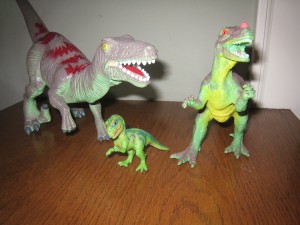Tag: salmon’
Why Worry about Genetically Modified Salmon?
- by KitchenPantryScientist
In the movie Jurassic Park, a tale of genetic engineering gone bad, scientists arrive on an island to find that an all-female population of resurrected dinosaurs may have found a way to breed. The following conversation ensues:
Henry Wu: You’re implying that a group composed entirely of female animals will… breed?
Dr. Ian Malcom: No, I’m simply saying that life, uh… finds a way.
As we find out later in the movie, the dinosaurs have indeed been breeding.
Salmon farmers tell us that a proposed population of genetically modified “super salmon“ will be composed entirely of sterile females, making it impossible for them to mate, should they escape to the wild. Some consumers are fighting FDA approval of the fish as food and say consumers should be alerted to the fact that they are purchasing the genetically engineered fish (by way of labeling.)
Advocates of the super salmon claim the meat from the new super salmon is indistinguishable from that of their natural cousins. However, critics fear that the new “frankinfish” may pose danger to both consumers and to the environment.
Super salmon are Atlantic salmon that have had a gene (DNA) for a growth hormone normally made by Chinook salmon inserted into their genetic map. In addition, scientists have put some DNA from another ocean fish, called a pout, in front of the growth hormone gene to keep the fish’s body pumping out growth hormone all of the time.
The don’t get bigger than natural salmon, but they grow much faster. This creates a potential threat to wild salmon, should the modified salmon escape from fish farms. (They would potentially out-compete and out-breed their natural counterparts in the wild.)
Despite claims that super salmon will all be sterile females, one article I read mentioned that ” a small percentage might be able to breed. They would be bred in confined pools where the potential for escape would be low.” Another stated that the FDA says that up to 5% of the eggs may be fertile.
Genetic engineering has resulted in many products that make people’s lives better, but we have to be aware of the danger it poses. Microbes, plants and animals can swap DNA and genetically modified organisms are already finding ways to invade the natural world.
Life finds a way, whether we want it to or not. It is not something to be taken lightly.
We are the Whales
- by KitchenPantryScientist
Whale hunting has been in the new a lot recently, but it now appears that the biggest threat to these intelligent, majestic animals is no longer whalers’ harpoons.
I read this morning in the Star Tribune that “Sperm whales, feeding even in the most remote reaches of Earth’s oceans, have built up stunningly high levels of toxic and heavy metals.” Most of these contaminants have been introduced into the ocean by humans of course. The article goes on to talk about how our food supply is being threatened by our poisoned oceans and that seafood is a primary source of protein for over 1 billion people. Do you eat fish?
Apparently, high concentrations of these poisons collect in these whales because they are at the top of the food chain. That means they eat fish and squid that have eaten smaller animals, which have eaten yet smaller animals and plants and so on. Humans are also at the top of the food chain, and although we don’t only eat contaminated fish, we eat many other plants and animals that are exposed to heavy metals, pesticides and herbicides. Both whales and humans nurse their young, passing contaminants from mother to baby. (That beautiful piece of wild salmon may not be as pristine as you’ve convinced yourself that it is. Like it or not, our bodies are full of toxins too.)
What’s happening to the whales is happening to us. The difference is that the whales are not the ones polluting the world.
Look at the Gulf. Looks at our sick oceans. Go read “The Lorax.”
We have to save the whales to save ourselves.
